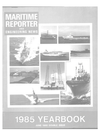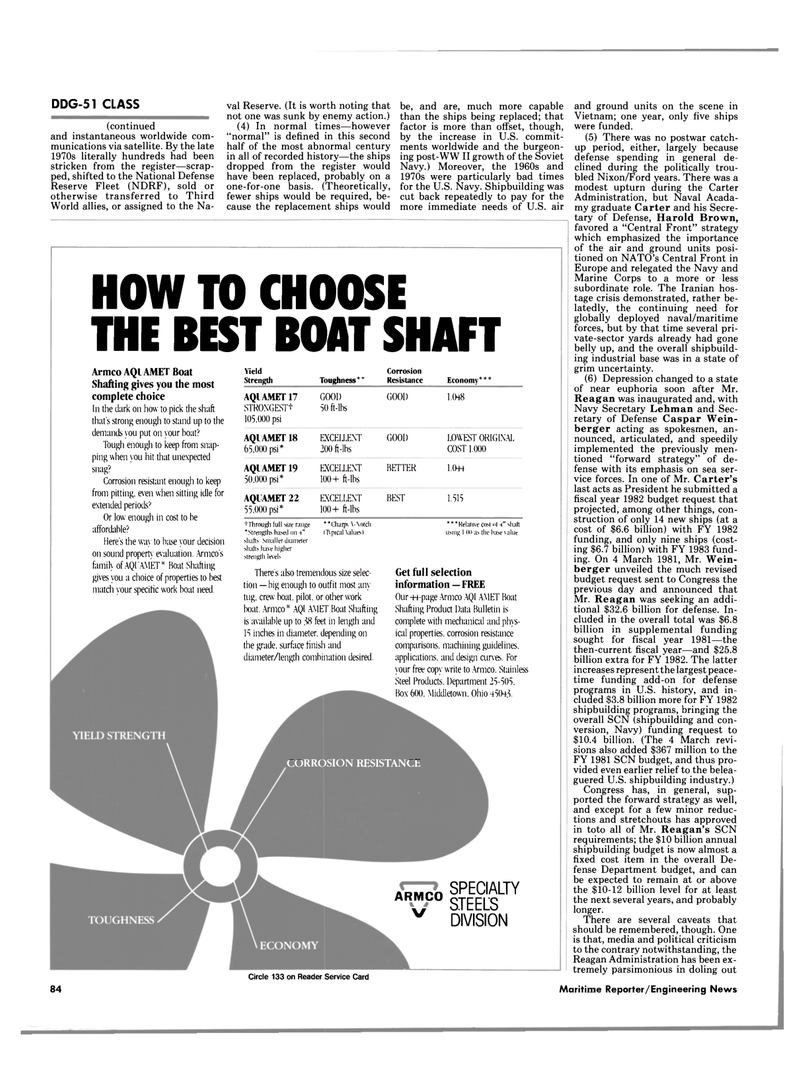
Page 86: of Maritime Reporter Magazine (June 1985)
Read this page in Pdf, Flash or Html5 edition of June 1985 Maritime Reporter Magazine
DDG-51 CLASS (continued and instantaneous worldwide com- munications via satellite. By the late 1970s literally hundreds had been stricken from the register—scrap- ped, shifted to the National Defense
Reserve Fleet (NDRF), sold or otherwise transferred to Third
World allies, or assigned to the Na- val Reserve. (It is worth noting that not one was sunk by enemy action.) (4) In normal times—however "normal" is defined in this second half of the most abnormal century in all of recorded history—the ships dropped from the register would have been replaced, probably on a one-for-one basis. (Theoretically, fewer ships would be required, be- cause the replacement ships would be, and are, much more capable than the ships being replaced; that factor is more than offset, though, by the increase in U.S. commit- ments worldwide and the burgeon- ing post-WW II growth of the Soviet
Navy.) Moreover, the 1960s and 1970s were particularly bad times for the U.S. Navy. Shipbuilding was cut back repeatedly to pay for the more immediate needs of U.S. air and ground units on the scene in
Vietnam; one year, only five ships were funded. (5) There was no postwar catch- up period, either, largely because defense spending in general de- clined during the politically trou- bled Nixon/Ford years. There was a modest upturn during the Carter
Administration, but Naval Acada- my graduate Carter and his Secre- tary of Defense, Harold Brown, favored a "Central Front" strategy which emphasized the importance of the air and ground units posi- tioned on NATO's Central Front in
Europe and relegated the Navy and
Marine Corps to a more or less subordinate role. The Iranian hos- tage crisis demonstrated, rather be- latedly, the continuing need for globally deployed naval/maritime forces, but by that time several pri- vate-sector yards already had gone belly up, and the overall shipbuild- ing industrial base was in a state of grim uncertainty. (6) Depression changed to a state of near euphoria soon after Mr.
Reagan was inaugurated and, with
Navy Secretary Lehman and Sec- retary of Defense Caspar Wein- berger acting as spokesmen, an- nounced, articulated, and speedily implemented the previously men- tioned "forward strategy" of de- fense with its emphasis on sea ser- vice forces. In one of Mr. Carter's last acts as President he submitted a fiscal year 1982 budget request that projected, among other things, con- struction of only 14 new ships (at a cost of $6.6 billion) with FY 1982 funding, and only nine ships (cost- ing $6.7 billion) with FY 1983 fund- ing. On 4 March 1981, Mr. Wein- berger unveiled the much revised budget request sent to Congress the previous day and announced that
Mr. Reagan was seeking an addi- tional $32.6 billion for defense. In- cluded in the overall total was $6.8 billion in supplemental funding sought for fiscal year 1981—the then-current fiscal year—and $25.8 billion extra for FY 1982. The latter increases represent the largest peace- time funding add-on for defense programs in U.S. history, and in- cluded $3.8 billion more for FY 1982 shipbuilding programs, bringing the overall SCN (shipbuilding and con- version, Navy) funding request to $10.4 billion." (The 4 March revi- sions also added $367 million to the
FY 1981 SCN budget, and thus pro- vided even earlier relief to the belea- guered U.S. shipbuilding industry.)
Congress has, in general, sup- ported the forward strategy as well, and except for a few minor reduc- tions and stretchouts has approved in toto all of Mr. Reagan's SCN requirements; the $10 billion annual shipbuilding budget is now almost a fixed cost item in the overall De- fense Department budget, and can be expected to remain at or above the $10-12 billion level for at least the next several years, and probably longer.
There are several caveats that should be remembered, though. One is that, media and political criticism to the contrary notwithstanding, the
Reagan Administration has been ex- tremely parsimonious in doling out
HOW TO CHOOSE THE BEST BOAT SHAFT
Armco AQIAMET Boat
Shafting gives you the most complete choice
In the dark on how to pick the shaft that's strong enough to stand up to the demands you put on your boat?
Tough enough to keep from snap- ping when you hit that unexpected snag?
Corrosion resistant enough to keep from pitting, even when sitting idle for extended periods'
Or low enough in cost to be affordable?
Here's the way to base your decision on sound property evaluation. Armco's family of AQI AMET8 Boat Shafting gives you a choice of properties to best match your specific work boat need.
Yield Corrosion
Strength Toughness** Resistance Economy***
AQIAMET 17
STRONGEST+ 105,000 psi
GOOD 50 ft-lbs
GOOD 1.048
AQIAMET 18 65.000 psi*
EXCELLENT 200 ft-lbs
GOOD LOWEST ORIGINAL
COST 1.000
AQIAMET 19 50,000 psi*
EXCELLENT 1004- ft-lbs
BETTER 1.044
AQI AMET 22 55,000 psi*
EXCELLENT 100+ ft-lbs
BEST 1.515 ^Through full size range 'Strengths based nil *t" "Charpv V\otch (IVpical Values) * "Relative cosi "I t" shaft using 1.0(1 as the base value shafts Smaller diameter shafts have higher strength levels
There's also tremendous size selec- tion — big enough to outfit most any tug, crew boat, pilot, or other work boat. Armco" AQIAMET Boat Shafting is available up to 38 feet in length and 15 inches in diameter, depending on the grade, surface finish and diameter/length combination desired.
CORROSION RESISTANCE
Get full selection information — FREE
Our 44-page Armco AQIAMET Boat
Shafting Product Data Bulletin is complete with mechanical and phys- ical properties, corrosion resistance comparisons, machining guidelines, applications, and design curves. For y our free copy write to Armco, Stainless
Steel Products, Department 25-505.
Box 600, Middletown. Ohio 45043.
ARMCO SPECIALTY STEELS v DIVISION
Circle 133 on Reader Service Card 84 Maritime Reporter/Engineering News

 85
85

 87
87
